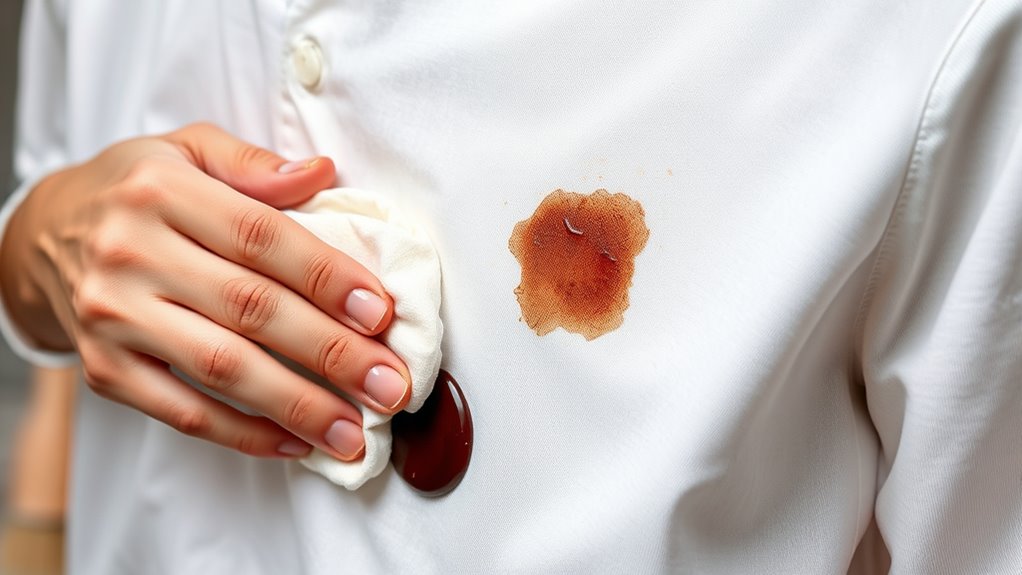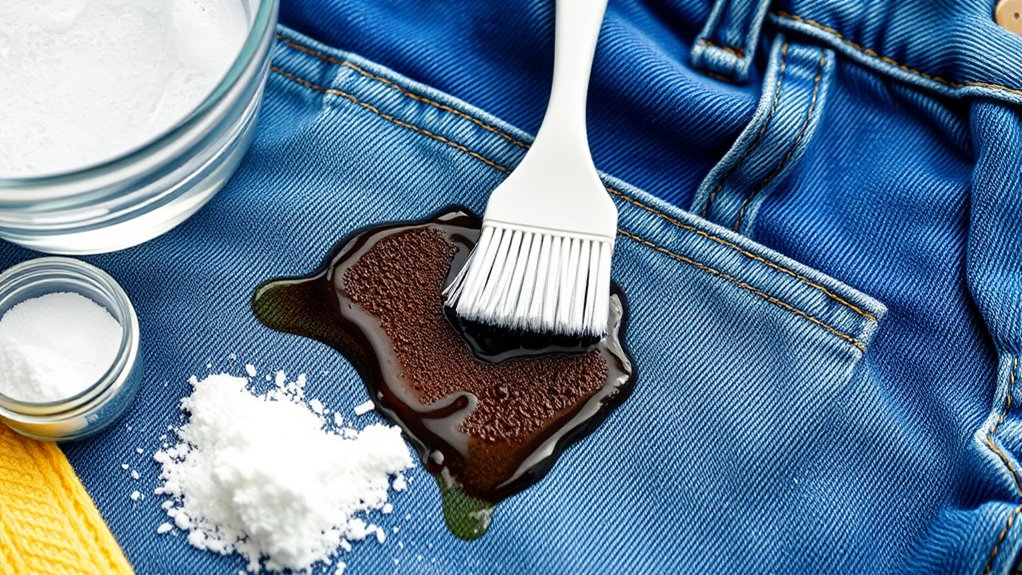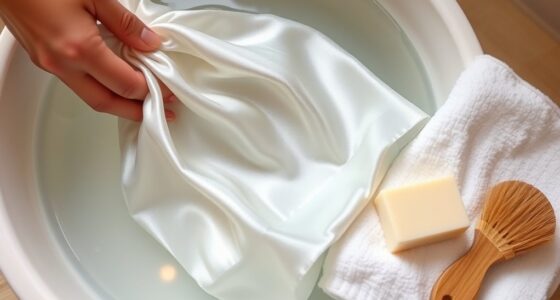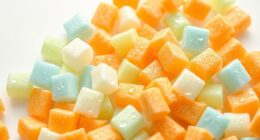Act quickly to treat oil and grease stains on your clothes. Blot off excess oil with a paper towel, then apply dish soap directly to the stain and gently work it in. Let it sit for 10-15 minutes, then rinse with warm water. If the stain persists, sprinkle baking soda or cornstarch to absorb oil, wait 15-20 minutes, and scrub gently. Proper techniques and patience can help you successfully banish stubborn stains—learn more tips along the way.
Key Takeaways
- Act quickly by blotting excess oil and avoiding rubbing to prevent deeper stain penetration.
- Use commercial degreaser or apply dish soap directly, letting it sit for 10-15 minutes before rinsing.
- Sprinkle baking soda or cornstarch to absorb oil, then brush off before further treatment.
- After treatment, wash in the hottest water safe for the fabric and check stain removal before drying.
- Repeat the process if needed and avoid heat until the stain is completely gone to prevent setting.

Oil and grease stains can be stubborn, but with the right approach, you can remove them effectively. The key is knowing which types of stain removers work best and how to make DIY cleaning solutions that tackle tough residues. First, act quickly; the sooner you treat the stain, the better your chances of complete removal. Blot the excess oil or grease with a paper towel or clean cloth, avoiding rubbing, which can push the stain deeper into the fabric.
Next, identify the type of stain remover to use. Commercial stain removers come in various formulations designed specifically for greasy stains. Look for products labeled as degreasers or those formulated for grease and oil. These are often the most effective because they contain powerful surfactants that break down the oil molecules. However, you don’t always need to rely on store-bought options. DIY cleaning solutions are excellent alternatives and can be just as effective. Common homemade solutions include a mixture of dish soap and warm water, baking soda paste, or even cornstarch or talcum powder to absorb excess oil.
Use degreasers or DIY solutions like dish soap, baking soda, or cornstarch for greasy stains.
To use a DIY solution, apply a small amount of dish soap directly to the stain, gently working it into the fabric with your fingers or a soft brush. Dish soap is designed to cut through grease, making it ideal for this purpose. Let it sit for about 10-15 minutes before rinsing with warm water. For more stubborn stains, sprinkle baking soda or cornstarch onto the stain, letting it absorb the oil for 15-20 minutes, then brush off and follow up with dish soap treatment. These powders are excellent for lifting oil from fabric fibers without harsh chemicals.
Another effective DIY method involves creating a paste with baking soda and water. Spread this paste over the stain and allow it to sit for 30 minutes. Afterward, scrub gently with a soft brush or cloth to lift the grease. For extra cleaning power, mix a small amount of vinegar with water and dab it onto the stain after applying the baking soda paste. Always test any homemade solution on a small, inconspicuous area first to guarantee it doesn’t damage your fabric. Understanding the contrast ratio of your projector can also help you ensure your viewing environment is optimized for the best visual results, especially in bright rooms.
Once you’ve pre-treated the stain with your chosen method, wash the garment in the hottest water safe for the fabric, according to the care label. Check the stain before drying; if it persists, repeat the treatment. Heat from the dryer can set the stain permanently, so it’s vital to make certain it’s gone before drying. With patience and the right combination of stain removers or DIY solutions, you can effectively eliminate even the most stubborn oil and grease stains from your clothes.
Frequently Asked Questions
Can I Remove Oil Stains From Delicate Fabrics Without Damage?
Yes, you can remove oil stains from delicate fabrics without damage. Start by gently blotting the stain with a soft cloth, avoiding fabric softeners that can worsen stains or damage fibers. Use a mild, stain-preventing solution like dish soap or a specialized stain remover, applying it carefully. Always test on a hidden area first. Patience and gentle treatment guarantee your delicate fabrics stay safe while effectively removing oil stains.
How Long Should I Treat a Grease Stain Before Washing?
Imagine a tiny sponge soaking up a spill—your stain needs similar attention. You should treat a grease stain for about 10-15 minutes, allowing the pre-treatment to penetrate and break down the oil. This stain absorption time guarantees the solution works effectively before you wash. Don’t rush; patience lets the treatment do its job, making your clothes look fresh and stain-free once you launder them.
Are There Natural Remedies Effective Against Oil Stains?
Yes, natural remedies and homemade solutions can be effective against oil stains. You can try applying baking soda or cornstarch directly to the stain to absorb the oil, then let it sit for about 15-30 minutes before brushing off. Alternatively, rubbing a mixture of dish soap and baking soda onto the stain works well. These natural remedies are affordable and environmentally friendly, making them a great first step in stain removal.
Will Using Hot Water Set the Stain Permanently?
Did you know that 70% of laundry mishaps involve improper temperature choices? Using hot water risks setting the oil or grease stain permanently, making it harder to remove later. To avoid stain setting, always start with cold water when treating oil stains. Hot water can lock in the stain, so steer clear unless you’re sure the stain’s already gone. Always check fabric care labels first!
Can Dry Cleaning Solvents Remove Stubborn Oil and Grease Stains?
Dry cleaning solvents can be effective at removing stubborn oil and grease stains, especially when the stain is fresh or lightly set. You can try using a commercial solvent or take the garment to a professional dry cleaner, who uses specialized solvents for tough stains. Keep in mind that solvent effectiveness varies depending on the stain’s age and fabric type. Always test on a hidden area first to avoid damage.
Conclusion
Remember, just like the alchemist turns lead into gold, you can transform stained clothes back to their original shine. With patience and the right techniques, you hold the power to conquer stubborn oil and grease marks. Don’t let a simple stain define your day—see it as a fleeting challenge, much like the fleeting shadows in a sunset. Your effort restores not just your clothes, but also your confidence to face whatever comes next.






